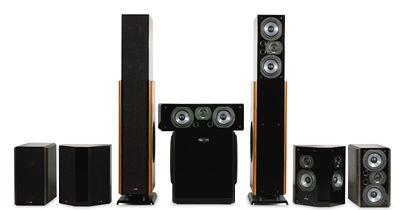Polk LSi Speaker System

Let's start with the towers with power. The 4-foot-tall LSi25 has two 5.25-inch aerated polypropylene cone midrange drivers set above and below a 1-inch ring radiator tweeter. Below and to the side is a 10-inch polymer composite cone woofer powered by a 150-watt amp. Stuck in between the towers is the LSiC center channel. This speaker employs the same drivers as the top portion of the LSi25; but, in the LSiC, the drivers are arranged horizontally. To suit your tastes and needs, you can switch the side surround speaker, the LSiFX, between dipole and bipole modes. It has the same drivers as the rest of the system, but one tweeter and one midrange driver are arranged on each side of the triangle-shaped cabinet. In the back are the LSi9 bookshelf speakers. It's really a shame to use these excellent bookshelf speakers as rear surrounds, but that's what I did. Don't feel bad for them; I moved them up front for part of my review. The LSi9s are just like the LSi25s, with the tower and power lopped off. As if the 300 watts in the two front towers weren't enough, the PSW650 adds 165 of its own, powering dual 10-inch polymer composite woofers on either side of a cabinet that's fashioned in the same high-gloss piano-style black that's prevalent in the entire LSi line.
 OK, 300 watts and 8 drivers, here I come. First, I tried out the LSi25s by themselves. I used Lexicon's MC-12B pre/pro and LX-7 amp for all of my listening. Nanci Griffith has led off my last few speaker reviews, so why stop now? Only this time, she took a turn at high resolution. Classic Records has put out Griffith's fantastic 1986 album The Last of the True Believers on 24/96 DVD. It's only stereo, but it has the resolution of DVD-Audio, and you can play it on most DVD players. Track 2 is "Love at the Five and Dime," which features Griffith's beautiful voice, as well as some excellent guitar work and Lyle Lovett on backup vocals. The first thing I noticed about the LSi25s is the tweeter. It doesn't look like a normal tweeter, nor does it sound like one. Its sheer neutrality and transparency are downright impressive. The guitars had a delicate aspect and never sounded bright or forced. To make sure this wasn't just the beauty of 24/96, I put in Griffith's Flyer CD. On many of the systems through which I've played this album, the mix of several high-pitched guitars turned into a barely listenable, treble-laced mush. The LSi tweeter and midrange drivers sorted through the mix with ease. They're also very focused, with a razor-sharp center image. The trade-off, of course, is in the soundstage, which doesn't drift far from the speaker edges in any direction.
OK, 300 watts and 8 drivers, here I come. First, I tried out the LSi25s by themselves. I used Lexicon's MC-12B pre/pro and LX-7 amp for all of my listening. Nanci Griffith has led off my last few speaker reviews, so why stop now? Only this time, she took a turn at high resolution. Classic Records has put out Griffith's fantastic 1986 album The Last of the True Believers on 24/96 DVD. It's only stereo, but it has the resolution of DVD-Audio, and you can play it on most DVD players. Track 2 is "Love at the Five and Dime," which features Griffith's beautiful voice, as well as some excellent guitar work and Lyle Lovett on backup vocals. The first thing I noticed about the LSi25s is the tweeter. It doesn't look like a normal tweeter, nor does it sound like one. Its sheer neutrality and transparency are downright impressive. The guitars had a delicate aspect and never sounded bright or forced. To make sure this wasn't just the beauty of 24/96, I put in Griffith's Flyer CD. On many of the systems through which I've played this album, the mix of several high-pitched guitars turned into a barely listenable, treble-laced mush. The LSi tweeter and midrange drivers sorted through the mix with ease. They're also very focused, with a razor-sharp center image. The trade-off, of course, is in the soundstage, which doesn't drift far from the speaker edges in any direction.
A little jazz is good for the soul, and Somethin' Else by Cannonball Adderley is one of my favorites. Also available in 24/96 DVD, this album highlights Adderley and Miles Davis at some of their best this side of Kind of Blue. The opening track, "Autumn Leaves," is notable through the Polks for a different reason than the Griffith tracks: the bass. On many systems, you can only hear Sam Jones' upright bass as low tones. Through the LSi25s, though, you can hear the pluck of the string and the individual notes. That is, after you spend some time getting these speakers set up right. Each tower has volume and crossover-frequency controls. While the latter has a factory setting, the volume does not. You're left on your own to fine-tune your speakers. I suggest that you bribe someone to stand behind each speaker and adjust the levels while you listen. Perhaps Polk could put something like that in the box. No, probably not. Shipping would be a pain. If you insist on setting up your speakers by yourself, expect a lot of getting up and sitting down and getting up again to get the levels to your liking. A factory setting on the volume knob would be welcome, even as just a starting point.
- Log in or register to post comments




































































